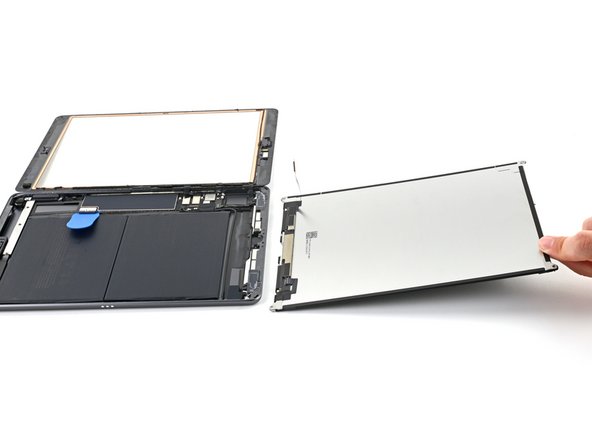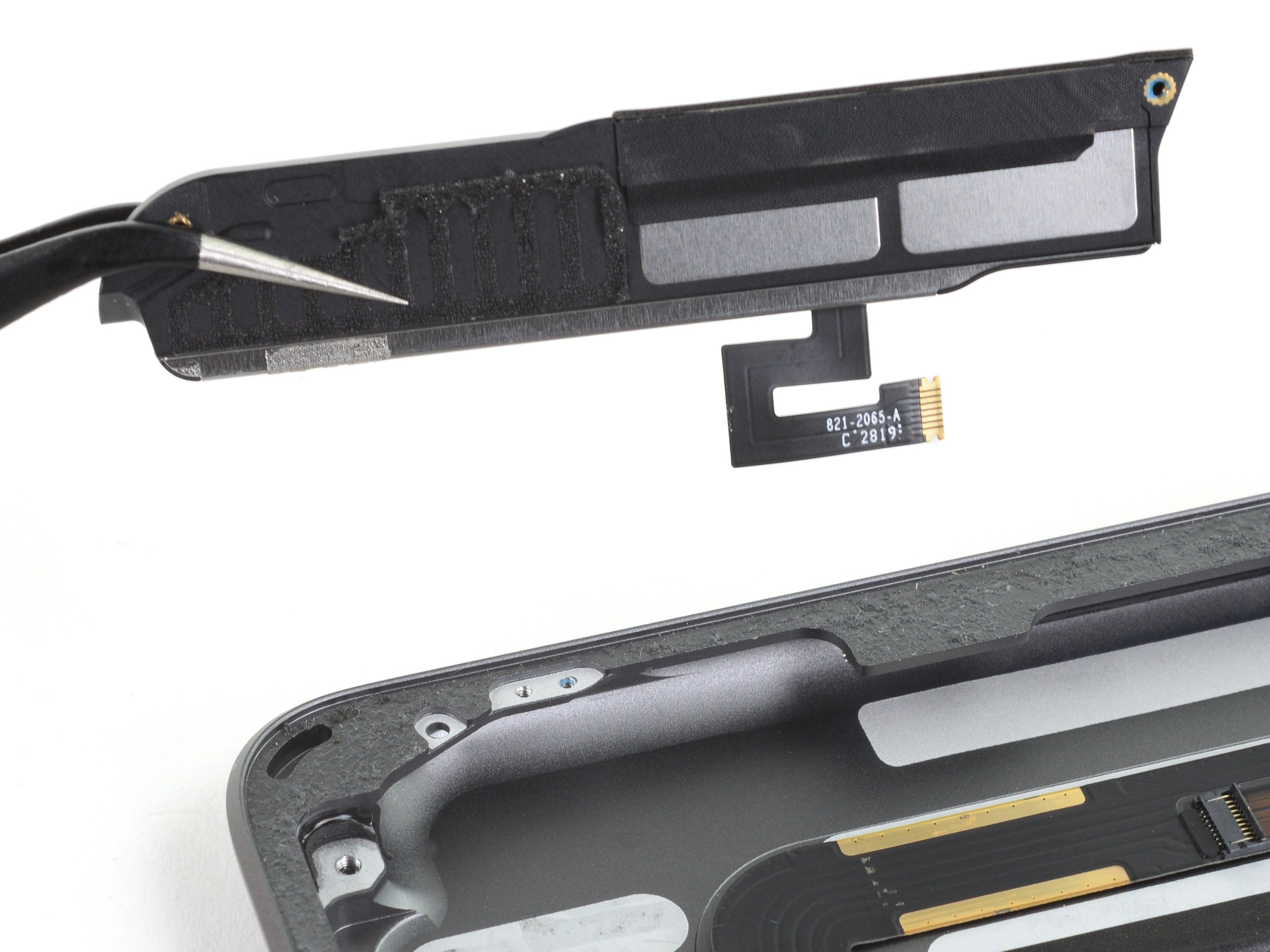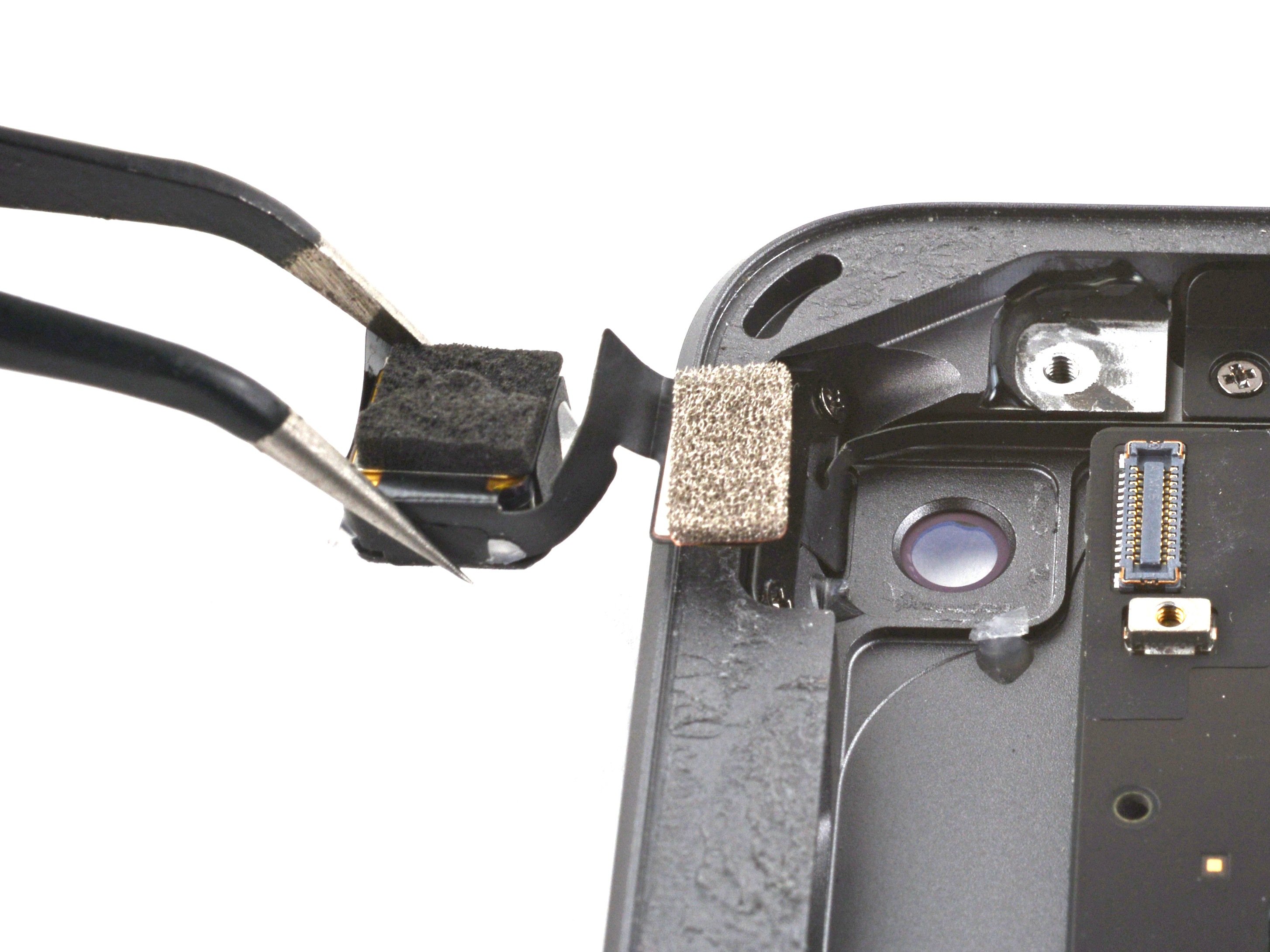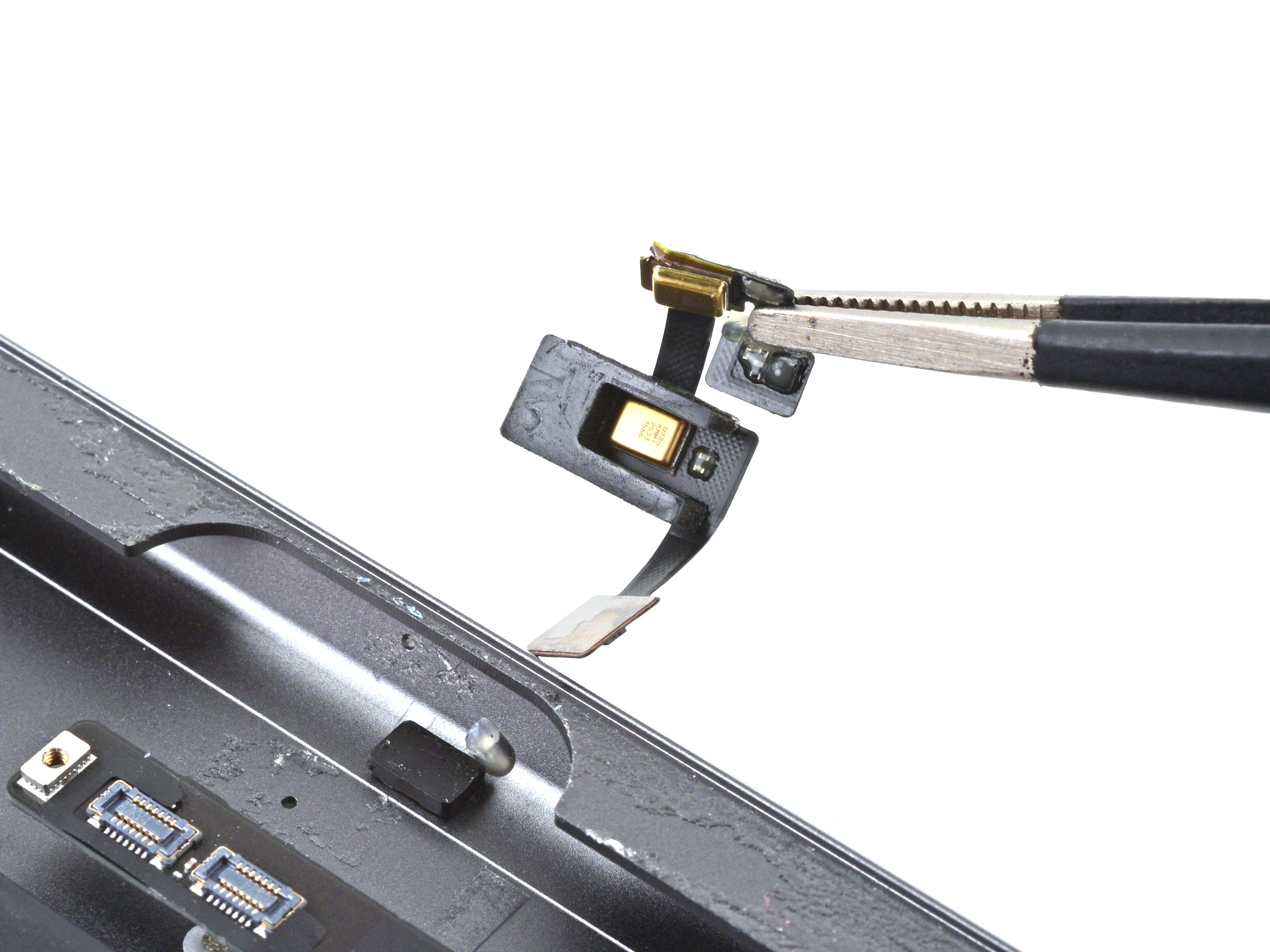iPad 8 Left Speaker Replacement
Duration: 45 minutes
Steps: 56 Steps
Hey there! Just a quick heads up: make sure to run that battery down to below 25% before you dive into disassembling your iPad. Safety first, friends!
Get ready to tackle the replacement of the left speaker in your iPad 8 Wi-Fi! Just a heads up, this guide is specifically for the Wi-Fi version, so if you’re rocking the LTE model, you might want to check out the other guide. Before you dive in, make sure your battery is below 25% charged – this helps keep things safe and sound, reducing the chances of a fire if something goes awry during the repair. And if your battery is looking a bit puffy, be sure to take the right precautions. When you’re isolating the battery with a blocker, be gentle; those battery contacts are fragile and can bend or break, leading to some serious woes. If you decide to skip isolating the battery, try to avoid metal tools unless absolutely necessary (like when you're removing screws) to keep everything running smoothly and avoid damaging sensitive components. Keep in mind that some photos in this guide might be from a different model, so they may look a tad different, but don’t worry – they won’t mess with the repair steps. Happy repairing!
Step 1
- Warm up an iOpener and stick it on the left side of your device for a solid two minutes. Time to soften things up!
Tools Used
Step 2
- While the adhesive is doing its thing and loosening up, keep an eye out for these tricky spots that really don’t like being pried:
- Front camera
- Antennas
- Display cables
Step 3
The next three steps are all about the Anti-Clamp, our handy dandy tool that makes opening up your device a breeze! If you’re going au naturel and not using the Anti-Clamp, feel free to hop down three steps for a different approach.
Curious about how to master the Anti-Clamp? Check out this guide for all the details.
If the surface of your iPad feels a bit too slick for the Anti-Clamp to grip, no worries! Just grab some tape to give it a little extra stickiness.
- Give that blue handle a gentle tug back to set the Anti-Clamp's arms free!
- Slide something under your iPad so it's chilling nice and level between the suction cups.
- Set those suction cups right around the midpoint of the left edge—one perched on top and the other below.
- Keep a steady grip on the bottom of the Anti-Clamp and give that top cup a firm press to get the suction going.
Step 4
- Give that blue handle a gentle tug forward to lock those arms in place!
- Now, twist that handle a full 360 degrees or until those suction cups start to stretch. You're doing great!
- Keep an eye on those suction cups and make sure they're dancing in sync. If they start to wobble out of line, just loosen them up a bit and get those arms back in harmony.
Step 5
Turn no more than half a twist at a time, then take a chill minute break. Let the Anti-Clamp and some patience do their magic!
Want to master the art of wielding a hair dryer like a pro? Check out this guide for all the details.
If your Anti-Clamp isn’t opening up enough space, just warm it up a bit more and give the handle a half-turn clockwise. Easy does it!
- Give it a minute to let the adhesive loosen up and create a small opening gap.
- If the screen isn't warming up enough, try using a hair dryer along the left edge of the iPad to gently heat it.
- Once the Anti-Clamp has made a big enough gap, slide an opening pick under the digitizer.
- Skip the next step.
Step 6
If your screen is sporting some serious cracks, don't fret! Slapping on a layer of clear packing tape can help your suction cup stick like glue. If you're feeling a bit adventurous, super strong tape can also do the trick instead of the suction cup. And if you're really in a bind, a little superglue on the suction cup can help it cling to that broken screen. Remember, if things get tricky, you can always schedule a repair.
- First things first, let’s warm up that screen until it’s cozy to the touch! Then, grab a suction handle and stick it to the left edge of the screen, getting as close to the edge as you can.
- Now, gently lift the screen with the suction handle to create a little gap between the digitizer and the frame. We’re making progress!
- Time to slide in an opening pick into that gap you just created. Let’s keep this momentum going!
Tools Used
Step 7
No need to stress if the opening pick is visible through the digitizer — just gently pull it out. Your LCD screen should be safe and sound, but watch out for that sticky adhesive that might be a bit tricky to clean up later.
- Slide a second opening pick into that nifty little gap you just made.
- Gently glide the pick towards the bottom-left corner of your device to free that stubborn adhesive.
- Keep the pick in the bottom-left corner so that adhesive doesn’t decide to play hide and seek again!
Step 8
- If the opening pick seems to be having a tough time with the adhesive, just give it a little roll along the side of the iPad to keep that adhesive separating like a champ!
Step 9
- Gently glide the first opening pick towards the top-left corner of your device to break that stubborn adhesive free.
- Keep that pick in the top-left corner like a trusty sidekick to stop the adhesive from re-sticking.
Step 10
- Warm up an iOpener and stick it on the top edge of your device for a solid two minutes to loosen things up.
Tools Used
Step 11
- Gently twirl the pick around the top-left corner of your device to break free that stubborn adhesive.
Step 12
Keep that pick away from the front camera; we don't want to accidentally give it a scratch! Follow these steps to keep everything looking sharp.
- Gently slide the opening pick along the top edge of the device, easing up until just before the front camera—smooth moves here!
Step 13
- Gently pull the pick out until just the tip is nestled between the digitizer and the frame.
- Slide that pick right above the front camera to break up the adhesive.
- Keep the pick close to the right side of the front camera as you move forward.
Step 14
- Pop that pick back in and slide it over to the top-right corner of your device to fully break free from the adhesive's grip.
- Keep that pick in place at the top-right corner to make sure the adhesive doesn’t decide to stick again.
Step 15
- Warm up an iOpener and stick it on the right edge of your device for a solid two minutes to get things nice and toasty.
Tools Used
Step 16
- Gently twist the pick around the device’s top-right corner to loosen that stubborn adhesive.
Step 17
The display cables hang out about halfway up from the bottom edge of your iPad. Slide your tool carefully and stop once you hit the three-inch mark from the bottom.
- Pop in a fresh opening pick and gently slide it right down the iPad's right edge to the middle. Keep it steady, and you'll be cruising through this repair in no time!
Step 18
- Warm up your iOpener and give it a cozy hug to the bottom edge of your device for a solid two minutes.
Tools Used
Step 19
Avoid rotating the pick all the way around the corner—you're at risk of damaging the antenna.
- Gently slide the pick down to the bottom-left corner to loosen that stubborn adhesive.
- Keep the pick resting in the bottom-left corner before moving on to the next step.
Step 20
Slide the pick towards the home button, not away from it, to avoid damaging the antenna. Easy does it!
If you need to slide the pick over this section again, just take it out and pop it back in at the bottom-left corner. Easy fix!
- Pop a new opening pick into that little gap you made at the bottom edge of the iPad. You got this!
- Gently slide the pick over the antenna, but stop just shy of the home button. Easy does it!
- Keep that pick hanging out to the left of the home button before moving on to the next step. You're doing great!
Step 21
Be careful not to insert the pick more than 1 mm. We don’t want to accidentally mess with the right antenna!
- Start by sliding your opening pick into the gap you've just made. Nice and easy, no rush!
- Now, gently slide the pick under the home button, angling it towards the bottom-right corner. Just the tip should go between the digitizer and the frame—be sure it stays neat and tidy!
Step 22
Just remember to slide that pick toward the home button, not away from it! We wouldn't want you to accidentally mess with the antenna. Keep it gentle and steady!
If you find yourself needing to glide that pick over this part again, just pull it out and pop it back in at the bottom-right corner. You've got this!
- Carefully reinsert the pick and glide it toward the home button, making sure to fully detach that pesky bottom adhesive.
- Now, leave that pick hanging out to the right of the home button as you move on to the next step.
Step 23
- Warm up that iOpener and let it chill on the right edge of your device for about two minutes. It's gonna make things a whole lot easier for you!
Tools Used
Step 24
Take it easy with this step! Make sure the adhesive is nice and toasty, and use a pick to carefully separate all the sticky bits. If you need a moment to reheat, go for it—better safe than sorry!
If you hit a stubborn spot, just warm up the edges again and gently wiggle your opening pick along them to ease things open.
- Gently twist the opening picks at the top left corners of your iPad. This should lift the digitizer just enough to peel away the last bit of adhesive. Easy does it, no need to rush!
Step 25
- Gently lift the left side of the digitizer and give the adhesive on the right side of the iPad a little extra nudge to separate it further.
Step 26
- Keep a steady hand on the digitizer while gently sliding an opening pick between the two display cables to carefully peel apart the last bit of adhesive holding them together.
Step 27
- After carefully loosening all the adhesive, gently open the digitizer like a book and lay it flat next to the iPad.
- When putting everything back together, take a moment to clean off any leftover adhesive from both the frame and the digitizer (if reusing it) using some isopropyl alcohol. Then, swap out the old adhesive with fresh adhesive strips or pre-cut adhesive cards.
- Pay close attention to the display cables as you reassemble—make sure they’re neatly folded under the LCD screen to avoid any accidental damage.
Step 28
- Grab your Phillips screwdriver and carefully unscrew the four 4.3mm-long screws holding the LCD in place. Take your time—no rush!
- As you go along, keep track of each screw and make sure they go right back where they came from. This will help prevent any unwanted damage to your device.
- Peel back any tape covering the LCD screws. We don’t need any obstacles in our way!
Step 29
Be careful not to remove the LCD completely just yet – it's still hanging on by a flex cable. Take it easy and proceed with caution!
- Grab your trusty spudger and gently pry the LCD out of its cozy little spot, just enough for your fingers to take over the job.
- Now, flip that LCD like you're turning a page in your favorite book—lift it near the camera and swing it over to the home button end of the frame.
- Place the LCD down on a clean, soft, lint-free surface to give those display cables some room to breathe.
Tools Used
Step 30
- Grab your trusty Phillips screwdriver and carefully take out the 2.3mm-long screw holding the battery connector in place on the logic board.
Step 31
Check out these snapshots showing the battery connector tucked under the logic board. Keep them handy as your go-to guide while you carefully unplug the battery.
Heads up: the battery connector features cantilever springs on the logic board that press against the battery's contact pads. Since both the logic board and battery are glued down, you'll want to slide a thin, flexible tool gently between these contact points to safely disconnect the battery.
Step 32
Handle the battery blocker with care! Those battery contacts are fragile little guys and can bend or break easily, causing damage you can't undo.
Make sure the battery blocker logo is facing up. It's like a little secret handshake for your phone!
Don't force the battery blocker under the connector. If it's being stubborn, try using a playing card to gently disconnect the battery instead.
The battery blocker or playing card should slide smoothly under the logic board with no resistance. Once it's in, it should be at a chill 15-degree angle, just hanging out.
- Gently slide the battery blocker under the logic board's battery connector at about a 35 degree angle.
- Keep the battery blocker in place while you continue working to stay safe and sound.
Tools Used
Step 33
- Grab your trusty Phillips screwdriver and get ready for some action! Time to tackle those three little screws that are holding the display cable bracket in place. Each one is 1.4 mm long, so make sure to remove them with care. You've got this!
Step 34
- Gently use tweezers or your fingers to pop off the display cable bracket—easy does it!
Tools Used
Step 35
- Gently use the flat end of a spudger to lift and unplug the LCD cable press connector.
- When reconnecting press connectors like this one, line up one side carefully and press down until you hear a click, then do the same on the other side.
- Avoid pressing in the center—if the connector isn't lined up right, the pins might bend and cause permanent damage.
Tools Used
Step 36
- Carefully detach the LCD and place it face down on a clean, soft surface that won't leave any lint behind. You've got this!
Step 37
- Grab a trusty pair of tweezers and gently peel away the tape that's keeping the home button cable ZIF connector cozy. You've got this!
Tools Used
Step 38
- Gently pop up the tiny, hinged locking flap on the home button cable ZIF connector using a spudger, an opening tool, or even your trusty fingernail.
Tools Used
Step 39
- Grab your trusty tweezers and gently tug on that home button ribbon cable to pull it straight out from the ZIF connector. You've got this!
Tools Used
Step 40
To keep your iPad in tip-top shape, remember to pry gently right on the connectors themselves—steer clear of the socket on the logic board. You've got this!
- Gently use the flat side of your spudger to pop up and disconnect the two digitizer cable connectors. Take your time, there's no rush!
Tools Used
Step 41
Be careful not to nick or rip the home button ribbon cable. It's more fragile than it looks!
- Grab your spudger and gently use the flat end to lift the vibration isolator from the bottom-right corner of your device.
- Once it's loose, go ahead and remove the vibration isolator.
Tools Used
Step 42
The home button cable is held in place with a bit of light adhesive. It’s not too tough to deal with, but just be gentle as you work your way through this step.
- Grab your tweezers and gently lift the home button cable off the frame like a pro.
Tools Used
Step 43
Grab your trusty opening pick and slice through any leftover adhesive that might still be sticking the front panel assembly to the frame. Let's free that screen!
Watch out! If those parts of the digitizer aren't properly insulated, they could accidentally ground out against other components. That could lead to some touch input hiccups, and we don’t want that!
The insulation is a sneaky little thing—it's not something you can spot with the naked eye, and it's different from the foam dust barrier strips you might find on many iPads.
- Start by removing the front panel assembly. Easy, right? Just take your time and stay gentle.
- If you're dealing with any pesky 'ghost' or 'phantom' touches on your shiny new display, no worries! Simply add a thin layer of insulating tape—Kapton (polyimide) tape works like a charm—around the highlighted areas on the back of the panel. Good news: replacement digitizers usually come with the right insulation, so no extra tape needed if you’re using one of those.
- Before you dive into reassembly, make sure to give your iPad a good clean. Any leftover adhesive needs to go! Grab some high-concentration isopropyl alcohol (90% or higher) and a lint-free cloth to clean the glued areas. This step preps the iPad for fresh adhesive and makes sure it sticks like it should.
- Now, it’s time to test things out. Power up your iPad and make sure everything is working smoothly. Once you’re all set, apply the pre-cut adhesive strips to the back of the display (check out the display adhesive guide for help). After that, you're good to seal it all up!
Step 44
- Gently slide the pointed end of a spudger underneath the left antenna cable and lift it straight up to disconnect it. Easy peasy!
- When it's time to put everything back together, those connectors can be a bit stubborn. Just hold each one over its socket and give it a little press down with the flat end of that trusty spudger. You'll hear a satisfying snap when it locks into place!
Tools Used
Step 45
Hold the antenna cable by the cable itself, not the connector—tugging on connectors is a quick way to snap them!
The tape holding down the left antenna cable is tucked right beneath the tape securing the right antenna cable. If things get tricky, gently peel up the right antenna cable first to get better access.
- Gently lift the left antenna cable away from the back case.
Step 47
- Grab your Phillips screwdriver and unscrew the three screws holding down the right antenna.
- One screw that's 2.3 mm long
- Two screws that are 1.4 mm long each
Step 48
The antenna cable is held in place by a small metal bracket attached to the speaker. This bracket is firmly crimped onto the antenna and glued to the speaker housing. To remove the antenna, you'll need to carefully cut through the adhesive. Take your time and go slow—no rush here!
- Slip an opening pick between the speaker enclosure and the bracket like a sneaky little ninja.
- Gently slide the pick toward the charging port to slice through that stubborn adhesive.
- Nudge the bracket away from the speaker so it’s free and clear of the tape hiding underneath.
Step 49
- Gently slide an opening pick between the antenna and speaker assembly to get things started.
- Carefully work the pick underneath the antenna to slice through the foam adhesive holding it down.
- Grab some tweezers or just use your fingers to lift out that left antenna with ease.
Tools Used
Step 50
- Grab a pair of tweezers (or even just your nails) and gently peel back the tape that's holding the speaker connectors in place. Nice and easy—no need to rush!
Tools Used
Step 51
- Grab the tip of a spudger, an opening tool, or even your trusty fingernail, and gently lift the small, hinged locking flap on the left speaker cable ZIF connector. You've got this!
Tools Used
Step 52
- Grab a trusty pair of tweezers and gently pull the left speaker cable straight out of the ZIF connector. You've got this!
Tools Used
Step 53
- Grab your trusty Phillips screwdriver and carefully unscrew the 2.3 mm screw holding the left speaker in place.
Step 54
- Peel away the tape that's keeping the speaker snug against the rear case. Let's set it free!
Step 55
- Slide the flat end of your trusty spudger into the groove in the speaker housing, right by the corner of the rear case.
- Gently nudge the speaker away from the rear case—easy does it!
- Carefully push the speaker out from under the shelf on the rear case and watch it come free.
Tools Used
Step 56
- Time to put everything back together! Just follow these steps in reverse order, and you'll be good to go.
- Got e-waste? Don't let it pile up. Take it to a certified recycler like R2 or e-Stewards to make sure it gets handled properly.
- Something went wrong? No worries! Try some basic troubleshooting, or reach out to our iPad 8 Answers community for some guidance.
-



















































































































































